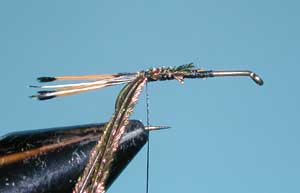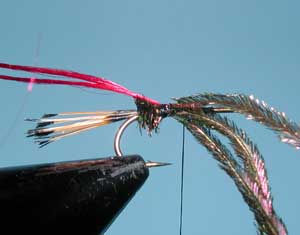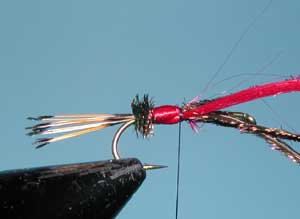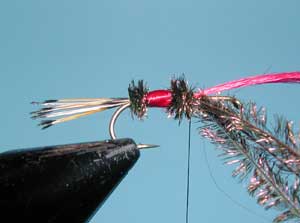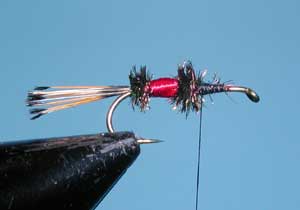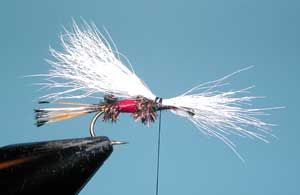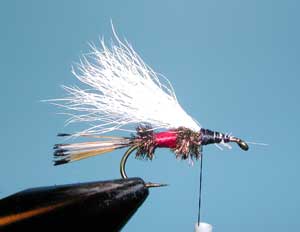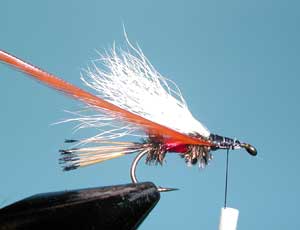Trude – providing a successful “joke”
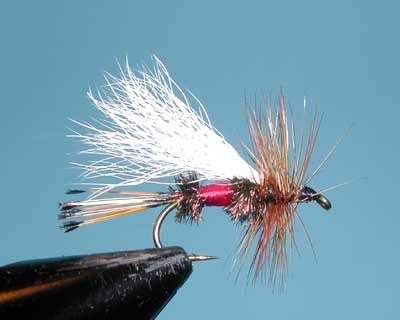
Royal Trude
Tying Instructions
| Materials
to Order Material, click the link |
|
|---|---|
| Hook | TMC 9300 #12-18 |
| Thread | Danville Black 6/0 |
| Body | Peacock Herl and Red Floss |
| Tail | Golden Pheasant Tippets |
| Wing | White Calf tail |
| Hackle | Brown Hackle |

Carter H. Harrison
Trude
The Trude is a down-wing dry pattern usually tied with a calf tail hair wing and a heavy hackle collar. Originally, the Trude was a streamer fly designed by Carter H. Harrison of Chicago, Illinois, in the summer of 1901 while he was a guest at the A.S. Trude Ranch near Big Springs, Idaho.Mr. Harrison was the mayor of Chicago from 1897-1906 and 1911-1915.
The fly was created as a joke using red yarn from a cabin rug for the body and hair from a red spaniel for the wing. The “joke” became an instant success and created great interest in the use of hair for a wing. The fly was adapted to a wet fly dressing by including a tail and switching to Fox Squirrel tail for the wing.
Original Trude
Hooks: 3/0 or 4/0 Streamer hook, later a wet fly hook
Thread: Black
Body: Red Worsted Yarn from a rug, later Red Wool
Wing: Red Spaniel Dog Hair, later Fox Squirrel Tail
Hackle: Red Rooster Hackle
Lots of Variations
The fly proved itself on the Snake River in southwest Idaho. Word spread to other parts of the western Rocky Mountains. Bill Beaty, one of Montana’s commercial tiers of the time, added the red goose quill tail. Cliff Wyatt of Santa Monica, California later added his variation to the pattern in the 1950’s with his Wyatt’s Trude that had an orange chenille body with a sweeping back guinea hackle intending to represent a “wet”stonefly and fished this pattern throughout the Sierra.
Pat Barnes designed his Sofa Pillow around the Trude pattern, being fished in West Yellowstone at the time, having a goose quill tail and floss body. Dan Bailey of Livingston Montana came up with his variations of the Trude, now being fished as a dry fly, not a wet fly. They had red, yellow and orange bodies with Adams-styled hackle. Later a lime colored dubbing was added and this fly, the Lime Trude, became one of the most popular variations being the choice for the Jackson Hole One-Fly Contest.
The Royal Trude, a variation off the Royal Coachman, was a favorite for Gary Lafontaine who caught over 300 trout each year with this pattern. Al Beatty also preferred this pattern as a searching pattern and would use Deer Hair rather than Golden Pheasant tippets for the tail. The Rio Grand King Trude was most likely a variation off the classic wet fly, Rio Grand King, that had a quill wing. Ray Bergman has a colored illustration of the pattern in his book, Trout(1938).
Really… another Hairwing pattern
By substituting the feather style wings with hair they often concluded that they had a Trude fly, never stopping to think that what they had was a hairwing variation. Such patterns as the Royal Coachman came to be known as the Royal Trude when it fact it could only be defined as a “Hairwing Royal Coachman”. Due to the down-wing shape, the trude is often fished as a dry fly with a downstream drift but retrieved as a wet fly or streamer. This gives the fly a unique ability as an attractor.
Variations
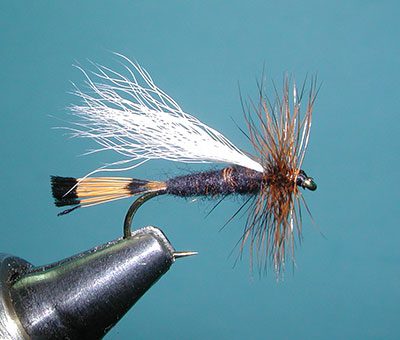
Rio Grand King Trude
| Hook | TMC 100 #10-16 |
| Thread | Veevus 10/0 Black |
| Body | Black Top Flight Dry Dubbing |
| Tail | Golden Pheasant Tippets |
| Wing | White Calf tail |
| Hackle | Grizzly Brown Hackle |
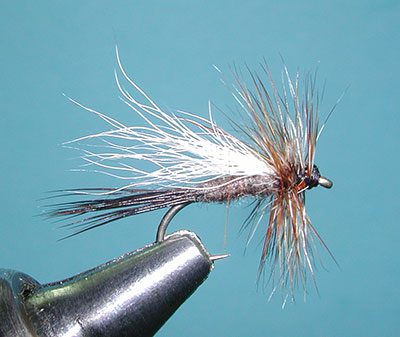
Adams Trude
| Hook | TMC 100 #10-16 |
| Thread | Veevus 10/0 Black |
| Body | Adams Gray Superfine Dubbing |
| Tail | Moose Body Hair |
| Wing | White Calf tail |
| Hackle | Grizzly and Brown Hackle |
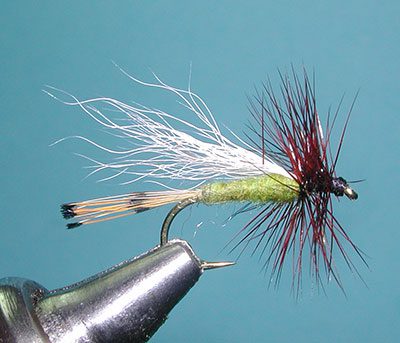
Lime Trude
| Hook | TMC 100 #10-16 |
| Thread | Veevus 10/0 Black |
| Body | Caddis Green Superfine Dubbing |
| Tail | Golden Pheasant Tippets |
| Wing | White Calf tail |
| Hackle | Grizzly Coachman Brown Hackle |
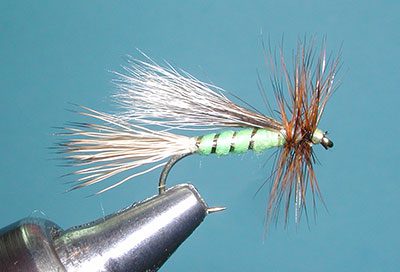
Yellow Trude
| Hook | TMC 100 #10-16 |
| Thread | Veevus 8/0 Pale Yellow |
| Body | Sulphur Yellow Superfine dubbing |
| Ribbing | Flat Gold Tinsel, narrow |
| Tail | Natural Bull Elk Hair |
| Wing | Gray Squirrel Tail |
| Hackle | Grizzly Brown Hackle |
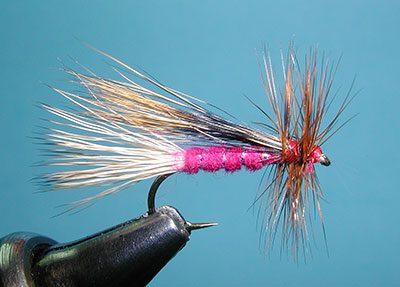
Red Trude
| Hook | TMC 100 #10-16 |
| Thread | Veevus 8/0 Red |
| Body | Red Superfine dubbing |
| Ribbing | Flat Silver Tinsel, narrow |
| Tail | Natural Bull Elk Hair |
| Wing | Fox Squirrel Tail |
| Hackle | Grizzly Brown Hackle |
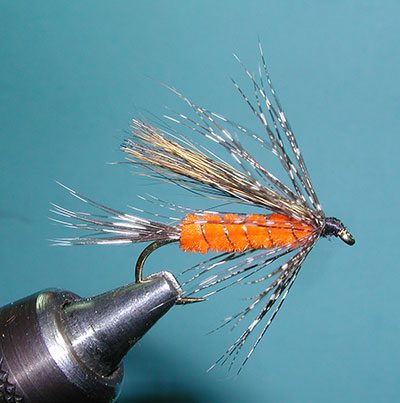
Wyatt’s Trude
| Hook | TMC 5262 #4-8 |
| Thread | Veevus Black 8/0 |
| Body | Orange Chenille, Standard |
| Ribbing | Oval Gold Tinsel |
| Tail | Speckled Guinea Fowl |
| Wing | Fox Squirrel Tail |
| Hackle | Speckled Guinea Fowl |


